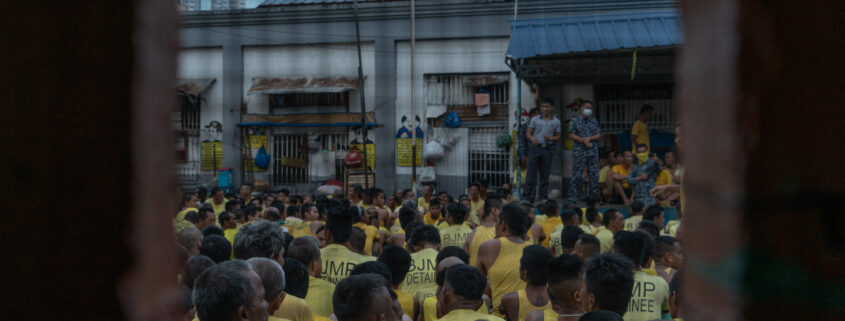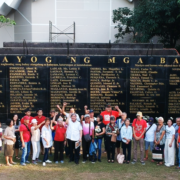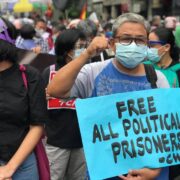The Old and New Bilibid Prisons in the Time of Pandemics
More than a century ago, Philippine prisons reeled from a flu pandemic. History might be repeated without adequate healthcare for prisoners and drastic interventions to stem the Covid-19 outbreak.
By Aie Balagtas See/Philippine Center for Investigative Journalism
Will the Philippines repeat the deadly record of the 1918 influenza pandemic in its jails and prisons?
On May 21, Henry Fabro, chief physician of the Bureau of Corrections, said fatalities in New Bilibid Prison (NBP) reached an “alarming” level: five inmates died in just one day.
At least 80 prisoners died from May 1 to May 19. The figure surpassed the prison camp’s average mortality rate of 50 to 60 deaths per month. Most deaths came from the Medium Security Compound, where inmates were cramped after returning to prison amid the Good Conduct Time Allowance (GCTA) fiasco.
“The numbers are alarming, that’s why I immediately hired two additional doctors and several nurses,” Fabro told the Philippine Center for Investigative Journalism in an interview.
“We wanted to contain it. So far, we were able to pull the death rate back to two per day,” he added.
In May, 40 out of an estimated 28,000 NBP inmates tested positive for Covid-19. One death was attributed to the highly contagious disease.
The death toll due to Covid-19 rose to 15 in June: 12 from NBP in Muntinlupa and three from the Correctional Institution for Women (CIW) in Mandaluyong, according to the Bureau of Corrections.
Fabro believes half of NBP inmates are infected with the virus. However, gauging the true extent of the contagion – with scant testing that yields “snail-paced” and “unreliable” results – is impossible, he said.
Case in point: two inmates were discharged from the NBP isolation area because the Department of Health said they tested negative for the virus, Fabro said. Days later, the health department said it made a mistake.
“We had to repeat the test and expand it to those they (inmates) interacted with,” Fabro said.
Reliable testing, he said, is important to slow infections in penitentiaries and determine which prisoner should be isolated.
This was not the first time a global pandemic tore through Philippine prisons. In 1918, more than 300 inmates throughout the country died. There were nearly 200 deaths at Old Bilibid alone. Back then, the national prison was right inside the capital Manila, on Oroquieta Street in Sta. Cruz district.
A 2009 study titled “The Philippines in the World of Influenza Pandemic 1918-1919” by historian Francis Gealogo said “almost all of the [Bilibid] inmates became sick of the disease during the height of the epidemic in October and November 1918.”
“Among the 2,674 cases of this disease treated during the year, 71 cases of lobar pneumonia complications occurred with 31 deaths. Almost all of the inmates had influenza, and of those who contracted complications in their respiratory organs nearly half died,” he said.
Gealogo said hospitals were so overcrowded during the flu outbreak that 1,897 Bilibid patients who could not be admitted were treated in their own brigades. “Due to influenza and pulmonary tuberculosis, the death rate for the year 1918 was higher than that of 1917,” he added.
The Annual Report of the Secretary of War published in January 1919 said a total of 378 inmates from four prison facilities died during the pandemic.
Old Bilibid had the most deaths with 193. It was nearly double the number of the previous year, which recorded 107 deaths.
Outstations were not spared. The report said Ihawig Penal Colony in Palawan had 72 deaths, San Ramon Penal Farm in Zamboanga City had 45 and Corregidor Island, 68. In 1917, Iwahig recorded 23 deaths, while San Ramon and Corregidor had four and 39 deaths, respectively.
The Old Bilibid Prison, built during the Spanish colonial regime in 1866, is now Manila City Jail.
A century ago, pulmonary tuberculosis was the chief cause of morbidity and mortality among prisoners.
Today, deaths in prisons are a result of multiple problems, such as poor healthcare services, lack of facilities and lack of government manpower and resources. The NBP hospital inside the maximum security compound, for instance, cannot adequately serve the overpopulated prison, and renovations were put on hold because of the lockdown, Fabro said.
The prisoners’ fear of isolation and hospitalization are another factor, Fabro added.
Inmates are also refused admission in hospitals, even in those run by the government, the official said. A nongovernment organization (NGO) working with prisons made the same observation, explaining that inmates are often turned away because they do not have money and relatives to accompany them. Prison guards are not allowed to accompany inmates in hospitals.
The coronavirus outbreak has made the problem worse.
Fabro said hospitals often rejected inmates by claiming they were operating at full capacity. “Recently, a dialysis patient was refused because the hospital learned that NBP has Covid-19,” he said.
The Department of Health did not respond to queries on hospital policies on the admission of sick prison inmates.
Fabro said emergency cases from NBP and the CIW were not spared of the apparent discrimination.
“Our Alpha Patient [of Covid-19] in CIW was refused by different hospitals in Mandaluyong. After hospital shopping, her relatives found a hospital that accommodated her,” Fabro said.
The Alpha Patient, or the first Covid-19 case in CIW, died on April 27. #
= = = = = = = = =
Aie Balagtas See is a freelance journalist working on human rights issues. Follow her on Twitter (@AieBalagtasSee) or email her at [email protected] for comments.







